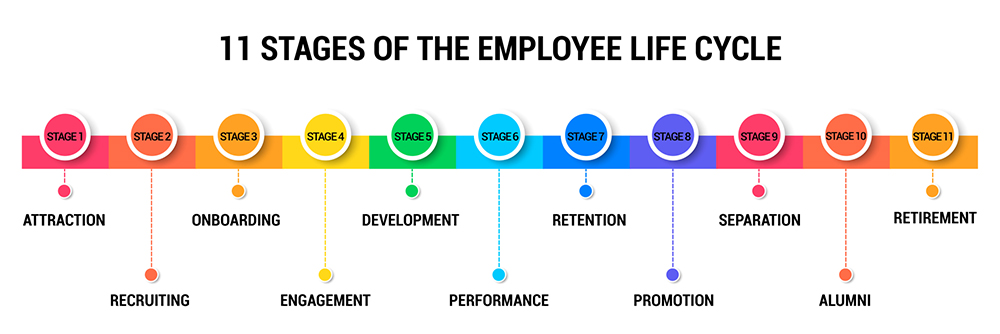
Employee interactions with an organization span a series of experiential phases starting from candidacy to alumni status – collectively termed the employee lifecycle. Each transitional milestone presents renewed needs and priorities to address. Understanding this 11-stage progression that employees go through in a company helps us understand how healthy the company culture is and shows us where we need to improve. Keeping track of how employees feel whether they are growing, and if they are leaving at different career stages is important for making HR programs better.
What is the Employee Life Cycle?
The employee lifecycle refers to the journey an employee takes with a company from initial hire to eventual departure. It includes key stages like recruitment, onboarding, performance management, and offboarding. Mapping employee experiences during this cycle reveals opportunities to enrich engagement during pivotal job transitions.
Why is the Employee Life Cycle Important?
Optimizing experiences across the employee lifecycle enhances attraction, productivity, and retention. Tracking metrics provides clues to continually refine initiatives at each transition stage. Journey mapping also reveals gaps warranting programs like onboarding, internal mobility, and offboarding enhancements. Tracking experiences across the employee lifecycle provides vital cues to enrich key transitional stages spanning hire-to-retire processes.
-
Attraction Stage Importance
The opening attraction phase sets the tone for talent to assess cultural fit. Running targeted employer branding campaigns highlights an organization’s award-winning workplace programs. Expanding referral sourcing channels through incentives taps into employee networks for quality hiring.
-
Recruitment Stage Importance
The recruitment experience conveys seriousness in winning targeted talent. Streamlining application procedures through easy-to-apply models paired with responsive communication signals care. Conducting structured interviews evaluating both competence and cultural alignment fosters quality hiring.
-
Onboarding Stage Importance
Fast-tracking the assimilation of new employees requires immersive onboarding support. Spanning organizational literacy, workstream capability development, and peer networking, such programs uplift early productivity. Surveying manager satisfaction on-ramp time, collecting early engagement feedback from surveys, and instituting 30/60/90 day connect check-ins provide onboarding effectiveness signals.
-
Engagement Sustenance Importance
Sustaining energy, purpose, and trust across continually evolving roles requires active nurturing programs. Publishing competency development roadmaps guiding career advancement builds line of sight. Impartial governance policies around performance evaluation and promotions establish fairness.
-
Learning Culture Importance
The pace of capability building across technologies and functions struggles to match external disruption cycles, increasing skill irrelevance risks. Building a culture that values continuous learning uplifts individual and organizational vitality. Enabling curated self-learning through digital content platforms empowers personalization while job rotations build cross-functional literacy.
-
Performance Enablement Importance
Elevating workforce productivity relies on facilitating smooth goal-cascading processes while granting teams the tracking technology needed for ownership. Integrating consistent formats for defining outcomes and key results across levels brings alignment. Enabling social recognition for achievements and milestones boosts motivation. Monitoring indicators around annual goal-setting rates, performance tracking technology usage levels, and value of peer recognition provides insights into the health of progress and talent management.
-
Retention Risk Management Importance
Inability to retain top talent has exponential costs across productivity, capability development, and hiring. Stay interviews help uncover pain points around growth or work-life balance for early intervention. Lead indicators tracking employee burnout likelihood allow mitigation programs to reboot energy. Manager-driven spot rewards for outstanding contributors signal value-based care, elevating morale.
-
Internal Mobility Importance
Elevating top talent into bigger roles via merit-based promotion streams signals a high potential culture reassuring aspirational needs. Ensuring process fairness, transparency, and support around transition capability development smooths internal progression.
-
Enriched Alumni Experiences Importance
Respectable farewell and offboarding experiences pave the way for departed talent to become brand advocates as alumni. Tactical focus areas span warm sendoffs, transparent exit interviews, and boomerang return opportunities.
In summary, the employee life cycle represents a perpetual opportunity to enrich experiences that attract, engage, develop, and retain top talent. Monitoring metrics around each transition stage provides clues to continually optimize initiatives in the quest for talent excellence.
Decoding the 11-Stage Employee Spell
Let us decode the 11 Stages of the Employee Life Cycle in detail:

-
Stage 1: Attraction
This opening stage encompasses early talent brand interactions aiming to lure potential candidates by positioning the employer value proposition. Building broad awareness as an employer of choice makes sourcing talent pipelines robust.
Key Focus Areas:
- Spotlighting award-winning culture via online media avenues
-
Participating in campus events to engage student communities
-
Paying forward through industry mentorship programs
Key Metrics to Track:
- Social media followers/likes reflecting the brand reach
-
Social media followers/likes reflecting the brand reach
-
Referral rates indicating affinity
-
Stage 2: Recruiting
With visibility and credibility established, the rigor of structured sourcing processes directly impacts the quality of applications attracted. Streamlined application procedures convey seriousness, while structured interviews deeply assess cultural fit.
Key Focus Areas:
-
Reducing application steps demanding extensive requirements upfront
-
Adding scenario-based questions testing behaviors
-
Adding scenario-based questions testing behaviors
Key Metrics to Track:
-
Offer acceptance rates reflecting experience
-
Time-to-hire from application to offer stage
-
Cost per hire benchmarked to industry standards
-
Stage 3: Onboarding
Beyond recruitment, smoothly assimilating new hires into the cultural fabric requires meticulous orientation guiding organizational literacy and capability ramp-up.
Key Focus Areas:
-
Peer buddy programs ease early networking
-
Stepwise training in foundational to advanced modules
-
Manager check-ins tracking progress
Key Metrics to Track:
-
Speed of capability build measured through ramp time
-
Engagement score from early feedback surveys
-
Manager satisfaction rating through 30/60/90 day connects
-
Stage 4: Engagement
With initial transitions handled, sustaining energy and purpose demands engaging employees at rational and emotional levels by continuously clarifying paths to achievement.
Key Focus Areas:
-
Development roadmaps guiding growth
-
Open communications nourishing trust
-
Impartial governance policies signaling fairness
Key Metrics to Track:
-
Program participation rates reflecting buy-in
-
Survey scores capturing the sentiment
-
Peakon or Culture Amp indexes for benchmarking
-
Stage 5: Development
Investing in continuous learning opportunities uplifts individual capabilities while expanding organizational knowledge assets. This is key for talent retention when career growth stagnates.
Key Focus Areas:
-
Self-driven learning platforms boosting personalization
-
Building cross-functional expertise through job rotations
-
Customized executive coaching for critical roles
Key Metrics to Track:
-
Training hours logged indicating uptake
-
Competency development rates measuring progress
-
Coaching effectiveness ratings hailing from participants
-
Stage 6: Performance
Beyond engagement initiatives, optimizing individual outputs to enterprise goals relies on reliable objective-setting and tracking mechanisms. Customized rewards and recognition further boost productivity.
Key Focus Areas:
-
Cascaded goal management processes
-
System enablement guiding progress
-
Crowd-sourced peer recognition
Key Metrics to Track:
-
Goal attainment levels signaling achievement
-
Goal attainment levels signaling achievement
-
Value of rewards unlocked measuring motivation
-
Stage 7: Retention
With focus areas around employee services and capability building covered, preserving top talent next necessitates nurturing inclusivity and trust. Competitive compensation benchmarking, along with intrinsic reward addressing interests, also matters.
Key Focus Areas:
-
Stay interviews uncovering friction areas
-
Lead indicator tracking around burnout
-
Spot rewards showcasing care
Key Metrics to Track:
-
Attrition rates mapped to tenure brackets
-
Distribution of tenure indicating potential
-
Exit interview feedback loop completion rate
-
Stage 8: Promotion
Growth orientation is pivotal for high performers and elevating competent contributors through internal job changes signals value-based progression. This boosts the aspirations of workforce members at large.
Key Focus Areas:
-
Talent review rigor ensuring fairness
-
Career stage appropriate development plans
Key Metrics to Track:
-
Internal fill rate
-
Compa-ratio
-
Role changes
-
Stage 9: Separation
Dignified exits prepare colleagues for success beyond current roles while building alumni affinity.
Key Focus Areas:
-
Offboarding checklist completion
-
Exit interview completion rates
-
Alumni rehire percentage
Key Metrics to Track:
-
Alumni rehire percentage
-
Referral rates
-
Social connections indicating continued affinity
-
Stage 10: Alumni
Staying engaged with former employees expands ecosystem connectivity, allowing enriched access to networks and skills.
Key Focus Areas:
-
Alumni events participation
-
Cross-referrals and social media connections
Key Metrics to Track:
-
Alumni participation rates
-
Referral rates benchmarked against competitors and social connections indicate affinity beyond tenure.
-
Social connections indicating continued affinity
-
Stage 11: Retirement
Supporting experienced professionals' transition smoothly into concluding chapters rewards them with financial security and continued purpose.
Key Focus Areas:
-
Assess retirement preparedness spanning financial, emotional, and social dimensions.
Key Metrics to Track:
-
Retiree satisfaction
-
Post-retirement adjustment surveys
-
Deferred compensation
Conclusion
Each phase presents opportunities to enrich experiences and signal care through the employee journey. Tracking sentiments around hiring, assimilation, growth, and exits provides clues to strengthen engagement across transitions. Just as journeys need occasional course corrections, monitoring people's processes helps reorient programs and keeps enhancements continual.



